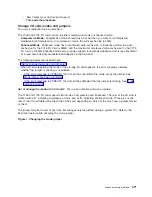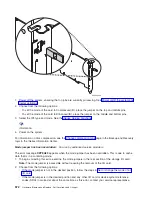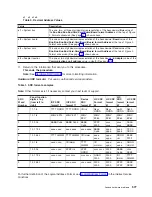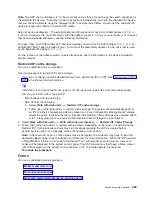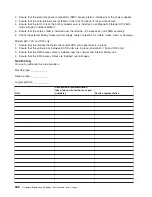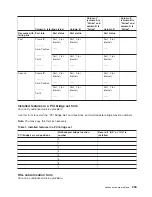
Cryptographic
I/O
processor
For
use
by
authorized
service
providers.
This
information
applies
to
Models
830,
840,
SB2,
and
SB3
only.
Attention:
The
type
2620
or
type
2628
cryptographic
I/O
processor
should
not
be
removed
or
disconnected
except
by
qualified
IBM
service
personnel.
Performing
this
action
for
any
reason
causes
the
loss
of
the
primary
encryption
key.
Before
disconnecting
or
removing
the
cryptographic
I/O
processor,
ensure
that
the
customer
has
access
to
a
record
of
the
primary
encryption
key.
After
any
service
action
that
involves
disconnecting
or
removing
the
processor,
the
customer
must
reinstall
the
primary
encryption
key.
This
is
the
only
way
that
the
customer
can
access
the
data
encryption
function.
Refer
the
customer
to
this
document
for
more
information:
IBM
Common
Cryptographic
Architecture
Services/400
Installation
and
Operating
Guide
,
SC41-0102
Determine
if
the
system
has
logical
partitions
For
use
by
authorized
service
providers.
This
procedure
instructs
the
user
on
how
to
determine
if
the
system
has
logical
partitions.
1.
Go
to
the
Primary
partition
system
console.
From
the
SST
or
DST
display,
select
Work
with
system
partitions
.
2.
At
the
Work
With
System
Partitions
display:
a.
Note
the
″
Partition
manager
release
″
.
b.
Note
the
″
Number
of
partitions
″
.
3.
Each
system
will
always
have
at
least
one
(1)
or
more
logical
partitions.
The
first
partition
in
the
system
will
always
be
named
the
″
primary
″
partition.
Some
systems
have
the
primary
partition
and
multiple
(secondary)
partitions
configured.
Is
the
number
of
partitions
one
(1)?
v
No
:
The
system
has
multiple
logical
partitions.
Read
and
understand
in
the
iSeries
Service
Functions
.
Then
return
to
the
procedure,
failing
item,
or
symbolic
FRU
that
sent
you
here.
This
ends
the
procedure.
v
Yes
:
The
system
does
not
have
multiple
logical
partitions.
You
are
working
with
a
system
that
has
a
primary
partition
only.
Return
to
the
procedure,
failing
item,
or
symbolic
FRU
that
sent
you
here.
This
ends
the
procedure.
Determine
if
the
system
has
guest
partitions
For
use
by
authorized
service
providers.
This
procedure
instructs
the
user
on
how
to
determine
if
the
system
has
Guest
Partitions.
1.
Go
to
the
Primary
partition
system
console.
From
the
SST
or
DST
display,
select
Work
with
system
partitions
.
2.
At
the
Work
With
System
Partitions
display,
the
number
of
partitions
and
the
partition
manager
release
level
are
shown.
This
is
the
release
level
of
the
Primary
partition.
Select
Display
partition
information
—>
Display
partition
operating
environment
.
3.
At
the
Display
Partition
Operating
Environment
display,
the
partition
identifier,
partition
name,
operating
system
type
(
″
OS/400
″
or
″
Guest
″
),
and
operating
system
version/release
will
be
displayed
for
each
system
partition.
If
there
are
any
guest
partitions
on
the
system,
they
are
labeled
as
″
Guest.
″
Analyze
hardware
problems
579
Summary of Contents for 270
Page 2: ......
Page 12: ...x Hardware Remove and Replace Part Locations and Listings...
Page 279: ...Figure 3 CCIN 2881 with pluggable DIMM Analyze hardware problems 267...
Page 281: ...Figure 6 Models 830 SB2 with FC 9074 HSL and SPCN locations Analyze hardware problems 269...
Page 283: ...Figure 1b Model 840 SB3 processor tower dual line cord Analyze hardware problems 271...
Page 294: ...01 gif port and LED locations 282 Hardware Remove and Replace Part Locations and Listings...
Page 295: ...s src rzaq4519 gif locations Analyze hardware problems 283...
Page 483: ...Table 1 Cover assembly FC 5095 Expansion I O Tower Analyze hardware problems 471...
Page 614: ...602 Hardware Remove and Replace Part Locations and Listings...
Page 618: ...606 Hardware Remove and Replace Part Locations and Listings...
Page 621: ......
Page 622: ...Printed in USA SY44 5917 02...







